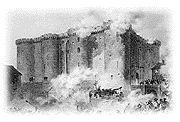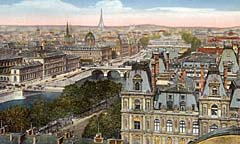
Paris is more than
2,000 years old. Gauls of the Parisii tribe settled there between 250
and 200 BC and founded a fishing village on an island in the river
that is the present-day Ile de la Cité -- the center around
which Paris developed.
 Known as Lutetia (Lutece) in
ancient times, Paris was conquered by Julius Caesar in 52 BC, and
existed as a regional center under the Romans and in the early Middle
Ages. In 987, HUGH CAPET, Count of Paris, became king of France, and
under his successors, the CAPETIANS, the city's position as the
nation's capital became established. Often characterized as spirited
and rebellious, the people of Paris first declared themselves an
independent commune under the leadership of Etienne Marcel in
1355-58. The storming of the Bastille in 1789 was the first of a
series of key actions by the Parisian people during the FRENCH
REVOLUTION. Paris also played a major role in the revolutions of 1830
and 1848. In 1871, during the FRANCO-PRUSSIAN WAR , the city was
besieged for four months until France surrendered. Known as Lutetia (Lutece) in
ancient times, Paris was conquered by Julius Caesar in 52 BC, and
existed as a regional center under the Romans and in the early Middle
Ages. In 987, HUGH CAPET, Count of Paris, became king of France, and
under his successors, the CAPETIANS, the city's position as the
nation's capital became established. Often characterized as spirited
and rebellious, the people of Paris first declared themselves an
independent commune under the leadership of Etienne Marcel in
1355-58. The storming of the Bastille in 1789 was the first of a
series of key actions by the Parisian people during the FRENCH
REVOLUTION. Paris also played a major role in the revolutions of 1830
and 1848. In 1871, during the FRANCO-PRUSSIAN WAR , the city was
besieged for four months until France surrendered.  After German troops
withdrew, French radicals briefly established the COMMUNE OF PARIS.
During World War I the Germans were prevented from reaching Paris,
but they occupied the city during World War II from 1940 to 1944.
Paris was again the scene of violence during the student riots of
1968. After German troops
withdrew, French radicals briefly established the COMMUNE OF PARIS.
During World War I the Germans were prevented from reaching Paris,
but they occupied the city during World War II from 1940 to 1944.
Paris was again the scene of violence during the student riots of
1968.
Paris today
maintains its importance, character, and charm, though its appearance
is being transformed by structures such as the BEAUBOURG and by the
ambitious grands projets building program carried out under
the presidency of François Mitterrand. In addition to the La
Défense arch and the Bastille Opéra, Mitterrand's
projects have included the renovation of the Louvre by architect I.
M. Pei, the La Villette complex on the northeastern edge of the city,
and, in the southeast, the Bibliothèque de France, a great
computer-age library.
Planning for Paris
and the Paris Basin region includes consideration of large land areas
in the Seine River valley all the way to the mouth of the river. New
towns, parks, industrial locations, and expanded functions of
existing towns are contemplated for this corridor on both sides of
the Seine.
Lawrence M. Sommers
Source: The New Grolier Multimedia Encyclopedia, Release #8, ©1996
Bibliography: Chelminski, Rudolph, Paris (1977); Couperie, Pierre, Paris
through the Ages, trans. by Marilyn Low (1971); Evenson, Norma, Paris (1979);
Flanner, Janet, Paris Journal, 2 vols. (1966-71) and Paris Was Yesterday, 1925-39
(1972); Roche, Daniel, The People of Paris (1987); Seigel, Jerrold, Bohemian Paris
(1987); Thomson, David, Renaissance Paris (1984).
|
|
|
|
"An absorbing and intimate history of the City of Lights. Carefully
tracing the evolution of the metropolis, Willms demonstrates how
political, economic, and cultural currents converged to make Paris
the "capital of Europe."
-- KIRKUS REVIEWS

|
|
|
|
|
by Johannes Willms, Eveline L. Kanes (Translator)
List: $40.00
Our Price:
$40.00
(this
title is not discounted)
Availability: On order; usually ships within 1-2 weeks.
Hardcover
Published by Holmes & Meier, Publishers, Inc.
Publication date: March 1997
ISBN: 0841912459
|
|
|
|
|
|
More recommended reading:
|

|
|
|
The Great Cat Massacre
and Other Episodes in French Cultural History
by Robert Darnton, 1984, Basic Books, Inc.,
published by Random House, Inc., New York.
|
|
Napoleon and Paris
30 Years of History
by Maurice Guerrini, translated by Mardery Weiner, 1970, Cassell
& Co. Ltd., London, printed by Ebenezer Baylis & Son, Ltd.,
The Trinity Press, Worcester and London, England (out-of-print).
|
|
The National Geographic Traveler - France
by Rosemary Bailey, 1999, National Geographic Society,
printed by R.R. Donnelley & Sons, Willard, Ohio.
Exploding with National Geographic's signature photography, this
book is one in a lush new series of guides from the folks whose
magazines have instilled wanderlust in multiple generations of
travelers. The France guide features insightful essays on history,
culture, and contemporary life in France, as well as walking and
driving tours. For serious explorers, there are detailed floor-plan
sketches of important sites such as Notre Dame and Versailles. Other
user-friendly touches range from color-coded regional sections to
quick-reference visitor information (hours, fees, telephone, etc.)
listed in side columns with keys to associated maps.
-- Kathryn True
|
|
Paris In the Terror:
June 1793 - July 1794
by Stanley Loomis, 1964, J.B. Lippincott Company,
Philadelphia and New York (out-of-print).
|
|
Paris In the Third Reich
A History of the German Occupation, 1940-1944
by David Pryce-Jones, 1981, Holt, Rinehart
and Winston, New York (out-of-print).
|
|
Paris Was Yesterday
1925-1939
by Janet Flanner, edited by Irving Drutman, 1972, The Viking Press, Inc.,
New York (out-of-print).
|
|
Pleasures of the Belle Epoque
Entertainment & Festivity in Turn of the Century France
by Charles Rearick, 1985, Yale University Press, printed
by Murray Printing Co., Westford, Massachusetts.
|
|
The Women of Montparnasse
by Morrill Cody with Hugh Ford, ©1984, Rosemont Publishing and
Printing Corp., printed by Cornwall Books, Cranbury, New Jersey
(out-of-print).
|
|
|

